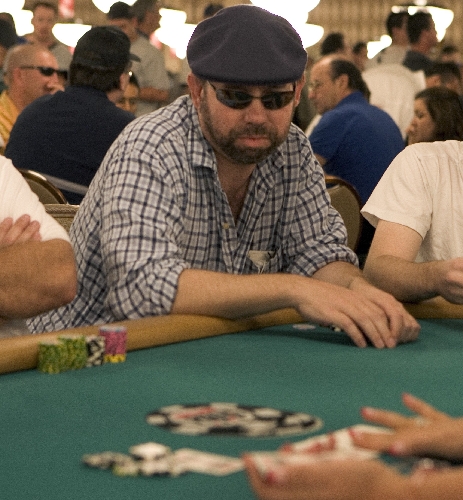Journalist dies in desert he loved

Warren Bates died in the place he loved best.
“The desert is ingrained deeply in my heart, coded into my DNA,” Bates wrote on his website that features haunting nighttime photographic images the Review-Journal assistant city editor took of lonely highways, railroad crossings and abandoned hulks of cars, half-buried and sticking out of the desert sand.
Bates, 49, was killed Friday seven miles outside the California ghost town of Amboy, more than 130 miles from Las Vegas, when a train broadsided his Toyota, according to the San Bernardino County Coroner’s Department. Witnesses told authorities that Bates was seen traveling on Route 66 and pulling ahead of the train before driving his car onto the tracks and stopping just before 5 p.m.
The California Highway Patrol is investigating the case as a possible suicide.
Bates spent his entire journalism career at the Review-Journal, joining the newspaper as an intern in May 1985, working for $4.50 an hour and impressing his bosses with his hard work and fine writing style.
As a reporter, Bates was known for both his hard-hitting federal court coverage as well as his ability to sniff out the unusual story in the most unusual places, sometimes writing first-person accounts.
In 1999, he traveled to one of his favorite places, the Mojave National Preserve, for a feature story on a solitary pay phone booth, describing it as “a lonely sentry at the end of a string of telephone poles about 75 miles southeast of Las Vegas and 10 digits away from anyone who wants to reach out and see if there’s life in the middle of the desert.”
In 2005, Bates wrote a first-person account of his unsuccessful bid to beat the big players in the World Series of Poker tournament, leading with this advice for high-stakes risk takers: “In order to live, you have to be willing to die.”
And that same year, Bates drove out on Route 66 to take photos of Amboy, the town where his life ended, to illustrate a story Review-Journal reporter Henry Brean wrote about the deserted place.
“He went out and took pictures himself — that is what he did,” Brean said Saturday. “He went out and shot pictures of the desert, of ghost towns and old railroad crossings. He would go and find these little out of the way places. We used to harass him and say he ought to write a book.”
Instead, Bates developed a website, www.roadtozzyzx.com, titled “where ruin is reborn” that featured his photos as well as stories about his extensive travels and lines from his favorite poems.
“Moving through things that move lies your end, and the wind stirs them further, and the moving takes you there,” says one poem by Sarah Manguso.
When Bates’ photos appeared five years ago in a Las Vegas art gallery, he explained what made him drive 250 miles for one shot, using the full moon, a flashlight or headlights to illuminate his subject.
“I love getting out of Las Vegas. I love the desert,” he said, calling what he finds to shoot modern ruins. “These were people’s dreams at one point. I still think there is some beauty in that.”
In November 1999, Bates was promoted to assistant city editor, a job where he helped shape young reporters and elevate stories of veterans who said he had a master’s touch.
“What Warren Bates could do as an editor is what all editors should dream of doing — strengthen copy within the writer’s style,” said Paul Harasim, who covers health and medical issues for the Review-Journal. “I used to tell him that he was the newspaper version of Maxwell Perkins, the greatest editor who ever lived. Perkins was the editor for Hemingway, Fitzgerald and Thomas Wolfe, writers with incredibly different styles — writers that he made better through editing.”
Harasim remembers going out with Bates on one of his middle-of-the-night photography outings and watching him shoot hulking Buicks in the desert under the enveloping moonlight at 1 a.m. Harasim and his wife purchased two of the pictures, which now hang in their living room.
“He loved to show how America weathers the storm of old age,” Harasim said. “I can’t imagine what life will be like now without him in the newsroom.
“You see, he stood for the best in journalism — do all you can to make sure you get the story right. That was Warren Bates of the Review-Journal.”
City Editor Mary Hynes, who worked next to Bates around the city desk central hub in the newsroom, called him “deeply intelligent, very gentle, compassionate, the consummate professional.”
“He was very creative,” Hynes said, fighting back tears. “He was a talented journalist and a talented photographer. He was a good poker player, too.”
Ched Whitney, the Review-Journal art director, said he regularly played poker with Bates and other colleagues and the group was scheduled to get together for a game tonight.
“I e-mailed him to tell him the game was going to be Sunday instead of Saturday so he could play and his reply was, ‘I’ll be there,'” Whitney said of the message exchange on Thursday.
Bates called in sick Friday and colleagues began to worry when he didn’t come in to work Saturday.
“It’s horrible,” Whitney said. “But I think he was in the place that he loved best when he died.”
Born in San Jose, Calif., on Jan. 24, 1961, Bates graduated with a journalism degree from San Jose State University.
He is survived by his father, Warren of San Jose, and his sister, Susana.
Contact Laura Myers at lmyers@ reviewjournal.com or 702-387-2919.